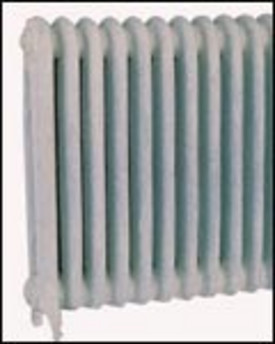Hot water heat can be delivered through a steam radiator, finned-tube baseboard, radiant panels, and radiant ceilings, walls or floors. It can be used in combination with other heat sources, such as forced hot air, active solar, or geothermal heat. With attention to design and planning, hydronic heat can even run in conjunction with your domestic hot water tank.
Feeling the Heat
Traditional steam radiators have given way to baseboard heat. Baseboard registers now look dated compared to radiant floors and walls, which use water at a lower temperature and provide a constant, warming presence. Radiant panels, which are broad surface heat emitters, are becoming increasingly popular in bathrooms, kitchens and bedrooms. These panels heat up quickly thanks to a series of tubes behind the panels and a broad surface to conduct and emit the heat into the room. Radiant panels are ideal in bathrooms, where immediate heat and warm towels are in high demand.
Heat Transfer
 |
||||
|
||||
The basics of hydronic heat are the same, regardless of the way you choose to enjoy the heat. With traditional baseboard heat, water leaves the boiler at approximately 180°F to 200°F and is sent through pipes throughout the house via a pump or circulator. The hot water enters various heating loops and conducts heat to the pipe, or panel to which it is connected. Once the heat has been transmitted to the surface or fins, the air within the room is warmed principally by convection. In this system, cold air is drawn across the warm surface, absorbs warmth as it passes and then moves upward. Cool air from below the heating unit is constantly being drawn into the unit as the warm air rises and flows on to spread warmth throughout the room.
Baseboard Heat
The most common type of hot water heat in the United States is finned-tube baseboard heat. Located close to the floor, finned-tube emitters are usually housed in metal enclosures that have reflective material behind them to encourage heat transfer from the fins or slats to the air passing over them, rather than being lost via conductivity through the cold wall behind it. The hot water pipes emerge from the floor and run directly behind the enclosure with thin, metal slats or fins, placed close together all along the pipe. Heat is transferred from the water to the pipe and ultimately to each of these fins. The fins serve as multiple heat emitters, warming the cold air from below. Enclosures must be located at least one to two inches above the finished floor to allow for adequate air circulation and heat transfer.
Piping
There are actually a number of different layouts for hydronic heat, but they all serve the same principle: Hot water leaves the boiler in a supply pipe, transmits its heat along the way, and returns to the boiler as cooler water (typically 150°F to 170°F) , ready for reheating and redistribution. The basic variable in the equation is how long the hot water stays out there before returning to the heat source. Obviously, if there are a number of registers or panels along the way, the water will steadily lose heat, delivering most of its heat in the first registers and imparting less warmth to those registers at the end of the loop.
To account for this strain on the system, different piping layouts are used and zones are incorporated to provide more even heat throughout the home. The simplest of all piping layouts is the series or single loop system. Here, water simply flows through the pipes, into each of the radiators along the way, without diversion. Since the water will have cooled about 20°F by the time it reaches the last radiator, this last emitter is typically sized much larger to take full advantage of the heat remaining in the water. A one-pipe system is slightly more elaborate and provides tees to divert water into each emitter along the way. In this way, radiators can be individually controlled so that heat need not necessarily always go to the first room on the loop.
Credit: Renovate Your World




























